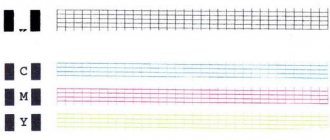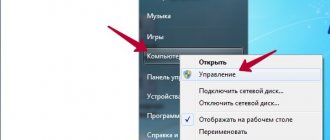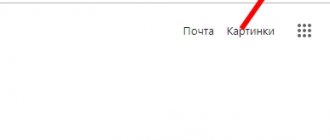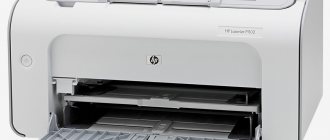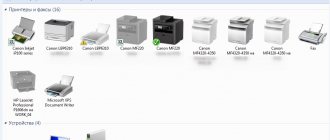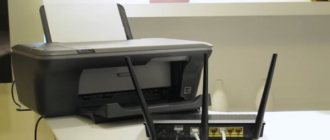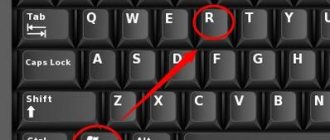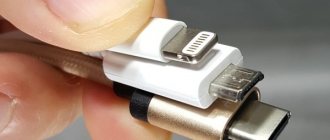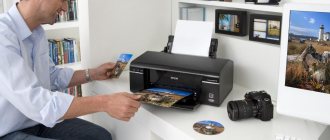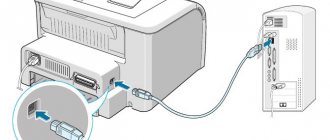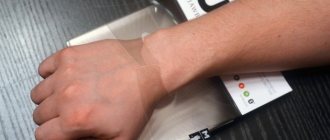In this material we will look in detail at all the reasons why an inkjet or laser printer does not print after refilling the cartridge. Although such incidents happen much more often with the former, “laser specialists” also have situations of this kind, which have their own specific solutions. The malfunction manifests itself in the form of a complete refusal of the equipment to work, and sometimes a white sheet without text or drawings simply comes out. All this happens with 100% presence of paint or toner, which is quite misleading for inexperienced users.
Here you will find instructions on what to do in a situation where even a new or just refilled cartridge does not print after replacement, and the printer writes “No ink” or shows that it is empty, although there is ink. Solutions have been proposed for problems with drying paints, the presence of air in “ink tanks”, and incorrect installation of consumables. Special attention is paid to the features of correcting errors in models of printing devices from different manufacturers.
What type of printer is the problem with?
- Jet 58%, 299 votes
299 votes 58%299 votes - 58% of all votes
- Laser 43%, 221 votes
221 votes 43%
221 votes - 43% of all votes
Total votes: 520
22.05.2019
×
You or from your IP have already voted.
Checking the settings in the operating system
It happens that the parameters of printing devices in the OS are reset to the basic ones. Most often this happens when installing a new printer or fax machine. In this case, it is worth checking the correctness of the settings through the control panel.
Selecting the desired device:
- Call up the search bar (Win + S) and enter “Control Panel”.
- Go to the “Devices and Printers” section.
- From the presented equipment, select the desired model and right-click on it.
- In the context menu, click on the line “Use as default”.
Another related problem is an overloaded print queue. This point is especially relevant for models connected via a local network.
Clearing the print queue:
- In the “Devices and Printers” section, double-click on the desired model with the left mouse button.
- Next, open the “View Print Queue” item.
- We remove unnecessary tasks from the list or completely clear it (“Document” -> “Cancel all”).
Advice! A more radical way to reset files sent for printing is to restart the computer. But this option will not work if the printer has an independent memory unit.
Problems with printer installation and printing in Windows
Fortunately, the majority of problems in the printing system related to software operation are very easy to resolve. These include:
- There is no printer driver in the operating system or the driver has failed.
- Disable the print service.
- The default print device is incorrect.
- User pauses printing.
- Switch the printer to offline mode.
- Problems with the document in the print queue (too large, not recognized, etc.). The printer still prints, but extremely slowly. Or instead of text it displays something similar to hieroglyphs.
- Denying access to the printing system by security policies.
More complex cases include damage to OS components, driver conflicts, and virus infection. Unlike the previous ones, it is not always possible to deal with them with a couple of mouse clicks.
Reasons why a network printer does not print:
- The printer port on the remote computer is blocked.
- The network path to the printer is incorrect.
- Sharing settings are incorrectly set.
To separate problems with the printer itself from problems with your computer, try printing the document from another PC or mobile device. If it (the printer) is connected via USB, if possible, connect it wirelessly and vice versa. Your task is to find out whether the print function works anywhere.
After making sure that the source of the failure is not in the printing device, but is connected to the computer, look at the device manager (the printer must be connected to the computer and plugged in). The absence of the “Printers” group in the list of devices and the presence of unknown equipment marked with an exclamation or question mark indicate that the system does not have the necessary driver. To solve the problem, just download it from the device manufacturer’s website (for example, HP, Epson, Samsung, Canon, Brother) and install it.
If the PC sees the printer, but it still does not print, look at the “Services” application (it’s most convenient to open it through the task manager tab of the same name).
Find Print Spooler in the list of services and make sure it is running. If not, right-click its properties. In the “Startup type” drop-down list, set “Automatic”, then click the “Run” button below.
Is the problem still there? Go ahead. Launch the “Settings” system application, go to the “Devices” - “Printers and Scanners” section (this and further instructions are discussed using Windows 10 as an example). The right half of the window displays a list of all installed printers, among which should be the one with which problems occurred. If it is not there, check the physical connection of the device to the PC. If there is, click "Open Queue".
Next, make sure that there are no stuck jobs in the print queue (if there are, delete and print another document). Open the "Printer" tab. The following points are important to us here:
- Is the default printer used (if not, perhaps the default printing device is a virtual printer, which instead of printing, for example, converts the file to another format).
- Is there a checkmark next to the “Pause printing” and “Work offline” items? If the printer goes offline on its own, it indicates a poor connection to the computer, a power problem, or a malfunction.
- If there are documents in the print queue, click Clear Queue and try printing a test page.
If the printer does not print only over the network, click "Sharing" and check if it is allowed to this device.
Next, look at the “Security” tab and make sure that your account is not prohibited from using the printing function.
The reason the printer is not queuing files could be one of the following:
- The paper is out or jammed.
- The toner or ink is low.
- A non-original cartridge is installed in the device.
- The print counter has reached its limit - printing is blocked.
- The user account does not have permission to print files.
- The device is faulty.
- There was a failure in the operating system.
Devices from different manufacturers block printing in different situations. So, when a cartridge runs out of ink, one machine stops processing documents and resets the print queue, while the other simply spits out empty sheets. The same is true in other situations. The specific problems that lead to blocking are usually described in the printer instructions.
Many printer problems are well recognized by their self-diagnosis system. If the device is equipped with a display, the cause of the failure is most often displayed on it. Diagnosis of simpler devices is carried out using their proprietary application. It is usually present on the disk that came with the device, as well as on the manufacturer’s website.
Below is an example of the troubleshooting function in the proprietary application of the HP Deskjet 1050 printer.
A stop when sending a specific document for printing is most often associated with the document itself. So, if the printer does not print a pdf file, perhaps the author has protected it from printing (pdf supports such functions). In such cases, the easiest way is to take screenshots of the pages of the problematic file, paste them, for example, into a Word document and easily print them out as pictures.
If hieroglyphs, “crazy words” or spaces appear on the printed copy instead of text, try replacing the font in the document with one of the ones preinstalled in Windows (all printers recognize them).
The main causes of problems in inkjet devices
Before troubleshooting the cartridge, you need to check the USB cable. Oddly enough, sometimes this cable is the cause of problems. If you don't have a spare cord, try moving all the connectors or connecting the cable to another USB port on your PC. If these actions do not improve the situation, then you need to look for other reasons why the printer does not print.
Ink has dried out in the nozzles
Inkjet printers have one big drawback: after a short period of time, the ink in the print head nozzles dries out. To prevent this from happening, you need to print something all the time, or turn on the printer once every few days (from 3 to 7) so that it “blows out” the nozzles.
Air got in when refueling
Air in a cartridge filled with ink will not cause much harm. Unless the paint begins to leak out of it, since there will be no necessary vacuum inside the container to keep the ink from leaking.
It's another matter when the ink runs out and air gets into the print head nozzles. In this case, the paint in the capillaries of the head may dry out. Air can also get in and dry out the head if it is parked incorrectly after the printer has finished running. It is important to check that the carriage always reaches the parking space. Only in this case will the nozzles be protected from drying out.
Air can damage the print head, especially on Epson printers since it is non-removable. The problem is that when changing ink tanks, if this is done leisurely, or when installing a CISS when the head is outside the parking unit, the nozzles have time to dry out.
Ink is not selected correctly
Some users think that ink is the same for all printer models. But in fact, even for devices of the same brand, ink may differ. The cartridge may not print due to incompatible ink being filled into it, which entails a complete flushing of the print head.
When choosing a paint, it is very important to read the instructions for it, which indicate the devices for which it can be used.
You should also pay attention to the expiration date of the ink.
The cartridge is not installed correctly
Sometimes a situation arises when the printer does not see the cartridge. This is explained by the fact that there are electrical contacts on it, which, when installed, must perfectly coincide with the contacts located inside the carriage. If for some reason there is a contact failure (dust, dried paint), the device will not work normally. It is also necessary to peel off the protective film from the contacts if the ink tank is new.
Some devices, especially MFPs, will not start working while the cover is open. The cause of equipment failure lies in a special lid sensor. Therefore, if you have installed a CISS, and the cable from it prevents the lid from closing tightly, then this sensor must be blocked, for example, with a piece of foam plastic (blocking methods may differ for different printer models).
Excess paint
Many users, when refilling the next time, try to fill the cartridge almost to the brim, which cannot be done. If the box is transparent, then you need to focus on the paint volume being approximately 90%. If the cartridge is darkened, then the operating instructions must clearly indicate the maximum permissible displacement.
It is also worth inspecting the box for microcracks. There should not be any fresh drops on the body after refueling. It doesn’t hurt to wipe it dry with a rag and leave it somewhere dry for a few minutes to make sure there are no leaks.
Inkjet printer does not print after refilling
Checking the cartridge
A newly refilled cartridge must be tested. You will need a clean paper towel or several dry white napkins. Press the bottom of the inkwell onto the paper surface with light pressure. Depending on the cartridge (b/w or color), a trace of black or a triple color stripe should remain on the napkin.
If the print has uneven edges, gaps or a trace of ink is not visible at all, then the reasons may lie either in air getting inside or in dirty passages.
You can check the cartridge using the software method. Here are the instructions using the Canon brand as an example.
- Find the model you need in the list of devices.
- Press RMB and select the line “Setting printing parameters”.
- In the window that opens, find the “Service” or “Maintenance” section.
- Select the desired procedure, for example, cleaning the printer nozzles to varying degrees, cleaning the print head, or calibration.
Paint drying in nozzles
Water-based inkjet inks thicken and dry out over time. If ink residue accumulates in the nozzles, clogs occur and the printer stops printing.
For preventive purposes, it is recommended to print a test page at least once every 3-7 days.
If the nozzles are still clogged, soak them in warm distilled water or alcohol, and after 5 minutes, wipe the remaining paint dry.
A more difficult task is to flush the head, which is located separately from the cartridge. We wrote about this in the last section.
Air entry
Air may have gotten inside while refilling the cartridge or continuous ink system. An ordinary inkwell reacts poorly to air bubbles; in such a situation, you can wrap it in a napkin and shake it like a thermometer. You will need to bleed air into the CISS, strictly following the instructions for your model. It is necessary to force the air plug out of the channel.
Plugs in CISS often form in the tubes running from the dye containers to the head. To remove excess air, remove the ink tank block, open the caps, insert a syringe filled with air, open the holes on the ink cans and blow out the channels.
For most printers with CISS, this sequence of actions is used.
When the ink runs out, air enters the head nozzles, which causes the paint in its capillaries to dry out. Air can also get in if, after printing is completed, the system does not park correctly, that is, the carriage does not reach the parking point. Due to drying out, the head fails. Such problems arise especially often in Epson printers with fixed heads.
Incorrect ink
Each model of printing equipment has a specific type and modification of ink tank. If you select a consumable that does not match the parameters, the printer may not see the cartridge. Original inkwells are expensive.
To save money, you can buy a compatible model, which is not available for every printer.
If there were no problems with printing with the old cartridge, and they appeared only after purchasing and installing a new consumable, there is a high probability that the issue is due to its incompatibility.
An inkjet printer may stop printing even with ink if it is not selected correctly. If the cartridge is filled with the wrong ink, you will have to do a complete flush, sometimes flushing the entire system and even the printing device.
When purchasing, be sure to look at the expiration date of the ink.
Ink overflow during refilling
The ink tank should be filled to no more than 90% of the total capacity.
If the ink tank is transparent, the refill level is visible visually. If the walls are thick, read the instructions or documents for the equipment, which indicate the maximum permissible volume of ink for refilling.
Incorrect cartridge or printhead installation
In an inkjet, the inkwell is fixed in a compartment called the carriage.
With intensive use, the mount becomes less strong, and the cartridge begins to move freely in the carriage, while contact is lost, and the printer stops “seeing” the consumable. To attach the cartridge, use a piece of cardboard or paper folded in several layers. Also check that the printer and cartridge contacts are not clogged.
The printer lid must be tightly closed as some models have open/close sensors.
If a CISS is installed, such a sensor must be blocked with a piece of foam plastic, since the system cable will interfere with closing the lid tightly.
When installing a new cartridge, make sure that all protective films have been removed from it. In some cases, you may need to reinstall or install the driver.
If, after cleaning or any other actions, the head is inserted incorrectly, read the instructions before replacing it. The manual can be found in the printer documents or on the Internet.
The cause of a white sheet may be a breakdown of the electronics caused by overheating of the head. This happens when there is no ink, but the nozzles continue to heat up so that dye is ejected from them for subsequent printing. The problem is typical for Canon and HP brands.
The chip, counter or diaper is damaged
- Chip. This is a tiny chip installed on each cartridge. Without a chip, the ink tank will not work. Intensive use of the printer leads to damage and scratching of the chip, which causes contact to be lost or the chip to fail completely. If the chip breaks, it needs to be replaced with a similar product. If the quality of contact deteriorates, you can clean the surface of the chip with a regular office eraser. In some consumables, the manufacturer provides for the need to regularly replace microcircuits, regardless of condition.
- Counter. The chip stores a lot of service data, including information about the number of printed pages. When the number of printed copies reaches a certain number, the printer software blocks printing. There are three methods to solve the problem: buy a new consumable, replace the microcircuit, reset the counter.
- "Pampers." A special pad that absorbs the remaining dye that comes out of the inkwell, but is not fixed on the paper. Over time, the “diaper” (absorber) absorbs too much paint and needs to be cleaned or replaced.
Laser cartridge
Sometimes after refilling the cartridge refuses to work normally or shows no signs of life at all. The cause of all problems lies, as a rule, in inept user actions, and at the same time deviations from instructions.
Procedure for replacing toner in a laser cartridge:
- Unscrew/remove the cover to access the toner compartment.
- We clean the box from accumulated old powder.
- We fill in a new toner (it is highly desirable to use a branded one, keeping in mind the brand of the printer).
- We remove any remaining powder (especially from the photocell and dosing blade).
- We assemble the cartridge and install it in place.
Advice! To clean the box from powder, it is more convenient to use a vacuum cleaner. If the cartridge is refilled more than a dozen times, then you should pay attention to the condition of the magnetic shafts and the cleaning blade (squeegee). If necessary, the latter are replaced.
Cartridge device
Just as with inkjet printers, laser cartridges are equipped with control chips. In some boxes they are brought out and can be accidentally damaged during the next refueling. The proprietary software of the equipment should notify you of this problem.
Laser printer stopped printing
In order for the laser printer to continue to work after the next refill without problems, you need to charge in the correct sequence.
- Remove the consumable from the device.
- Disassemble the cartridge, first unscrewing all the screws.
- You clean the waste bin, no matter how much powder remains in the compartment.
- Add new toner of the desired brand and quality.
- Eliminate traces of powder if it accidentally spills onto the removed parts.
- Clean the dosing blade and photo roller. A regular or special vacuum cleaner is used.
If this is not the first refill, the reason for the printing stop may be wear and tear on the parts. When visual damage is visible on the consumable, the cartridge needs to be replaced. First, carefully inspect the squeegee (cleaning blade), image drum, and magnetic roller.
There is a chip on the cartridge of a laser printer (as on an inkjet printer), the counter of which remembers the number of printed sheets. When the number reaches the set mark, the system automatically blocks the ability to print. Then you need to reset the toner counter or reset the cartridge. We described in detail about reset/zeroing in the next section of the article.
If the laser device was not used for a long time, the powder in the cartridge could cake. To resume work, just shake it lightly so that the toner inside the hopper is evenly distributed.
Problems with the chip or diaper counter
Inkjet printers use two types of cartridges: disposable and refillable. In disposable ones, the manufacturer installs a special chip that blocks the operation of the device after the ink in the container runs out. The printer also refuses to print if the diaper counter indicates that it is full.
Control chip
Each cartridge is equipped with a small chip that contains a variety of service information. The chip is quite fragile, and it is easy to damage it, for example, during the next ink refill. Most proprietary applications that service the printer signal a failure of the chip.
Chip on cartridge
If such a message appears, then the first thing you need to do is inspect the chip for contamination. Dried paint can be removed with a cotton swab dipped in alcohol or a regular rubber band if there is not much dirt. In other cases, you will need to replace the chip or the entire cartridge.
The chips also read the number of pages printed. Some boxes are limited by limits, after which they simply stop working. Reflashing the microcircuit, or again replacing it, helps.
Absorber
Most often, this element is called a “diaper” or absorbent pad. The absorber is necessary to remove excess ink while cleaning the cartridge nozzles. By means of a mini-pump, a zone of low pressure is created in the nozzles, while in the body itself it is close to normal. Due to the difference in pressure, the paint clots are pushed out and fall on the gasket.
Many devices can monitor the level of absorption of the absorber and issue appropriate messages or an error code. If the diaper is completely clogged with ink residue, the printer may refuse to print.
Diaper filled with ink
In a good half of cases, replacing a gasket is a rather labor-intensive procedure, so it is better to leave this matter to specialists. In addition, not every utility allows the user to reset the pollution indicator counter.
There is no universal method for eliminating problems with diapers and chips, since the design of the devices is different. Different printer models have their own troubleshooting methods.
Troubleshooting Brother printers (MFPs)
Brother printers do not have sensors that monitor the overfilling of the diaper with waste ink, and therefore the adsorber is controlled at the software level. The calculation is made based on the number of prints that came out of the machine, as well as on the number of head cleanings (forced and regular). After some time of operation of the unit, the program counter determines that it is time for the diaper to be overfilled and blocks the printer, while the message “Cleaning” or “Error 46” is displayed on the device display. To reset the counter, no additional software is required. The device has a reset function through the service menu. To get into it, do the following.
- Unplug the device's power cable from the outlet.
- While pressing and holding the “MENU” key, connect the power cable to the electrical outlet.
- Wait for the “Maintenance” message to appear on the screen for a couple of seconds. At this moment, you need to have time to remove your finger from the “MENU” key. If that doesn't work, unplug the outlet and do it all over again.
- By clicking on “+”, wait until the number 8 appears, then click “OK”.
- Using the “+” key, select number 2, and then “OK”. After these steps, you should see the message “MACHINE ERROR” or “MACHINE ERROR 00”. If such a message does not appear, but some other message is displayed, then you will not be able to reset the diaper counter.
Brother printer
Next, you need to move on to the soft reset procedure itself:
- follow the steps above up to point 3 (inclusive);
- then use the “+” button to select the number 0 and then press the “OK” button, the image “00:00 XX:XX” will appear, where XX:XX is the time;
- Now you need to press the “BLACK AND WHITE” key (it, as well as the “COLOR” key, can be found near the “START” button) until the inscription “PURGE: xxxxxx” appears (instead of xxxxxxx there can be any numbers).
At the next stage, for the inscription “PURGE” you must enter the special code “2783”:
- Use the “+” key to find the number 2 on the display and press “OK”;
- further, “+” → “7” → “OK”;
- “+” → “8” → “OK”;
- “+” → “3” → “OK”.
- after this you should see the message “PURGE:00000”;
- by pressing the “BLACK AND WHITE” key, select “FLUSH: xxxxxx”;
- repeat all the actions that were done after selecting the “PURGE” inscription;
- after selecting number 3 and clicking “OK”, you will see the message “FLUSH:00000”, then turn off the printer, unplug it and turn it on again.
After the counter is reset, the printer will continue to operate. It is also recommended to remove the diaper itself, rinse it and dry it, but this will require disassembling the device. Understanding how to do this will require a separate article.
Solution for Canon printers
Canon ink tanks have a chip installed that counts the amount of ink remaining in them. When, in the “opinion” of the chip, the ink runs out, an error message appears or about an empty cartridge. Therefore, you need to turn off the counter.
If Canon PG510 / 440 / 426 ink tanks are installed, then press “OK” in all messages that appear on the device’s display. Press “OK” until a message appears asking you to press the button to enable paper feed. Hold it down for a few seconds and the paint counter will be reset. For other cartridges, the reset occurs after pressing the button with the image of a triangle in a circle for 5-10 seconds. or in the printer settings on your PC.
Printing equipment manufacturer Canon uses 2 types of print heads in its devices: non-removable and removable, located directly on the cartridge.
We revive Epson printers
Ink accounting in Epson printers is done by their own software (firmware). Therefore, no matter how much ink you add, the program will consider that the container is empty and block printing.
To return the device to operation, it is customary to use the PrintHelp program, which is freely available on the Internet and is free. In addition, it can be used for most Epson printing equipment.
Using this program, you can not only reset the ink to zero, but also monitor its quantity. The program is also able to detect the overflow of a diaper and, if necessary, reset it.
Restoring HP printers
It's no secret that HP 121, 27, 28, 56, 57, 21 and 22 ink tanks are refillable. In this case, you need to be careful and not allow the ink to be completely depleted by refilling it on time. When the chip detects that the ink is running out (but there is still paint), a message is issued about this: an exclamation mark appears next to the problem ink tank. In this case, you need to click on “Continue”, thereby turning off monitoring of the paint level. The disadvantage of this method is that you will not be able to see the ink levels.
If you do not add ink after this and continue to print, then after it is used up, a sensor that determines the actual amount of ink will work and block the operation of the printer and the chip itself. And a cross will already appear opposite the cartridge. If this happens, you will have to replace the chip or ink tank. Although there are several ways to reset the chip so that the paint level is displayed.
Place the inkwell on the table with the contacts facing up and do the following.
- You will need to seal 1 contact, highlighted in green in the figure, with tape. It is important that only 1 contact is sealed.
- After this, you need to insert the ink tank into the machine, click “OK”, which will appear in the message window, and print the internal test of the unit.
- Remove the ink tank from the printer again.
- Next you need to close another contact. You can choose any one (blue, purple, red) without removing the sticker from the previously closed contact.
- Insert the part back into the printer, click “OK” and print a test page.
- Remove the ink tank from the machine again.
- Remove the sticker from the first contact, then return the part to the machine. You should wait until the unit “sees” the ink tank, and then remove it.
- You will need to remove the sticker from the second contact, wipe all contacts with alcohol, and put the ink tank back into the printer.
The meaning of these manipulations is this: four different cartridges are replaced, after which information about the identifier of the refilled ink tank is erased from the device’s memory, and it, inserted fifth, is considered as new . After this, the printer will assume that there is paint and display its level in the containers.
The second method is suitable if the first one was ineffective:
- seal the first contact, insert the inkwell into the machine, and print the test as in the first method;
- Without removing the sticker from the first contact, you need to glue three contacts with a rhinestone, as shown in the figure;
- insert the part into the machine and print the test;
- remove all stickers and return the ink tank to its place, remembering to clean the contacts with alcohol.
If the HP laser printer does not see the cartridge
Problems with cartridge recognition in laser printers arise for similar reasons as in inkjet printers.
- The toner has run out. The first thing to do is always check the toner level in the cartridge.
- The chip is not recognized.
- The cartridge is not installed correctly.
The cartridge is original and new
If the cartridge is original and new, the issue is most likely due to correct installation.
For laser printers, the problem of an undetectable cartridge is often solved quite simply: open the lid and insert the cartridge, then close the lid, leaving a small gap for your finger. Using your finger inside the printer, we feel for the cartridge and “squeeze” it.
There is always a possibility that, under the guise of a new cartridge, you were sold a compatible analogue or a “refurbished” original. If you do not use alternative consumables, buy cartridges from official Hewlett-Packard dealers.
The cartridge is original, but it has already been refilled
Checking the toner level and the correct installation of the cartridge are also relevant in this case.
If the original cartridge has survived several refills, the elements by which the printer recognizes the presence of a cartridge could fail. Or the digital print resource counter has triggered.
In the first case, the failed element must be replaced, in the second, the chip must be re-flashed.
Checking the cartridge with proprietary software
In this case, there is no need for direct user contact with the cartridges: the procedure is controlled through the printer software. You can find it on the official website of the equipment manufacturer in the “Drivers and Utilities” section.
Nozzle cleaning and calibration:
- Open the “Control Panel”.
- Go to "Devices and Printers".
- Click on the desired model.
- Select the line “Setting Printing Options”.
- In the window that appears, find the “Service” section (“Maintenance”, etc.).
- Click on the icon of the required procedure.
Checking the nozzles
Most utilities allow you to check the nozzles, clean the print head and calibrate it. Blowing out the nozzles takes about 1-2 minutes, actively consuming ink. Therefore, the cartridge must be filled at least 50%. If necessary, the procedure can be repeated.
Physical problems
Checking the connection
The quality of the connection of the power cable and the cord connecting the printing device to the computer is immediately checked. The corresponding button on the body of the first one must be turned on. If the connection is made via Wi-Fi, the signal level is checked. The lights on the printer should be lit to indicate that it is ready for use.
The reason is paper
The paper may not be securely seated in the tray, or there may be a paper jam inside the printer. Such problems need to be eliminated. Also check whether the paper meets the specifications of your printer model. The optimal paper density for the printer is 80 g/sq.m.
Do not use damaged or previously used sheets.
Check that you have loaded the paper the correct way into the tray. Photo paper and envelopes have a printable side, but a non-printable back side.
Clogged or dry cartridges or print head
With intensive and frequent printing without preventive maintenance, the ink passage channels in the middle of the cartridge or print head become clogged with ink, and dust or foreign matter from a low-quality consumable can also get into them. If you rarely print on the printer, the ink may dry out on different surfaces of the device. For any reason, the printer may refuse to print not only with black ink, but also with color.
Cleaning can be physical or software. In the first case, user intervention is required to wash the equipment and remove any remaining ink. The second uses utilities or standard software from the manufacturer, which includes a head cleaning function.
The supply channel is cleaned as follows:
- Go to the printer settings and in the “Approximate ink levels” section, check the amount of dyes in the containers.
- Print a test sheet to make sure washing is necessary.
- Remove the print head and wash it with a special liquid. Typically, printer manufacturers produce liquids themselves; for example, HP offers formulations based on sodium sulfoethosylate and isopropylene alcohol.
- The effect of the product begins 10-20 minutes after application.
- Wipe the head, dry it and put it back in its original place.
- Go to the print device settings and in the “Print head cleaning” section, select “Enhanced cleaning” and click on “Start”.
- To check the result, print a test page again.
- Repeat washing if necessary.
Cleaning cartridges must be done one at a time.
An ink tank removed from the printer should not be left outside its permanent location for more than 30 minutes.
Incorrect cartridge refilling
- Poor quality paint. Bad ink can be refilled in both black and color cartridges. Paints can only be purchased from an official manufacturer or a reliable supplier.
- Inappropriate dye. If the device refuses to print, but there is ink, check whether it matches your printer model. The dye markings are on the packaging, and recommendations for choosing ink are in the instructions for the equipment. When choosing ink for inkjet printers, you need to consider that they come in pigment and water-based types.
- Ink overflow. When refilling a cartridge, you need to fill ink no more than 90% of the total volume. If a color printer smears black on the paper, it means there is a problem with the black cartridge, and when it smears, for example, red, it means there is a problem with the container containing the color dye.
- The seal of the cartridge is broken. The container needs to be pulled out, checked for leaks, and, if necessary, sealed with tape over the hole through which the filling took place.
- The cartridge is installed incorrectly after refilling. It is enough to remove the container from the device and install it again until a characteristic click appears.
Checking Ink Levels
You can check it visually if the cartridge is made of transparent plastic. After aligning the cartridge, make sure that the ink volume is greater than half the capacity. If the level is low, refuel.
If it is impossible to estimate the amount of ink by eye, use a software method to check it.
- Go to “Control Panel” - “Hardware and Sound” - “Devices and Printers”.
- Find the printer you need in the list and right-click on it.
- From the list of options, select “Printing Settings”.
- In the “Maintenance” tab, click on “Status Information”.
- Select the “Ink Data” tab.
If the printer has stopped printing with color ink, you need to check its level first, since this is the main reason for failure to print for color printers.
Non-original or incompatible cartridges/ink
If the original cartridge that was sold with the printer is worn out or broken, and you buy another one, and then the text does not print, although there is ink, most likely the consumable is of poor quality or is not suitable for your model. A similar situation may occur if ink that is incompatible with the cartridge model was purchased. Before purchasing non-original consumables, you need to check their compatibility with your printing equipment.
Print head problems
It is impossible to identify a broken head yourself, much less repair the part without sufficient skills. You need to contact the service center. It is difficult to visually determine such a breakdown, but sometimes burnouts and ink leakage can be seen on the PG, which are a sign of a malfunction in the electrical components of the printer.
Cleaning Fixed Printheads
Before you start washing this part, you will need to prepare a small container in which the washing process will take place. This could be a saucer, a plastic box with small sides, a photo bath, etc. You will also need: gauze or bandage, a pair of syringes (10 ml), plastic and rubber tubes, which are found in medical droppers. Rubber bands will be needed if a strong blockage is found that cannot be removed by soaking.
For flushing, it is recommended to use flushing liquid, sold at ink stores. But, since the price of liquids is quite high, you can use household chemicals, namely “Mr. Muscle” (MM) for washing glass, containing ammonia.
Please note that the color of the chemical is either green or blue. Other colors of liquid are not suitable for flushing.
Next, you need to remove the print head itself. Since there are a great variety of devices of this type, each case has its own nuances. A video of the process of removing the head for any printer can be found on the Internet.
Easy way
So, when everything is prepared, do the following.
- Draw MM into the syringe.
- Cut 2 small pieces of gauze. Fold the first one so that it is the size of the lower platform of the PG, then place it in a saucer and soak it in the MM. Crumple the second piece and also soak it a little with glass liquid.
- Turn the PG over with the nozzles up and use a crumpled (moistened) piece of gauze to remove all dirt from it. You may need to change several gauze pads.
- Place the PG on the prepared area of gauze in the saucer. Use a moistened MM gauze swab to remove dirt from the intake grates (be careful not to break them).
- After removing the rubber bands from the inkwells, rinse them under water to remove dried ink, and wipe the areas where they were with gauze.
- Next, you need to drop one drop of MM onto the intake grids using a syringe.
- Once the MM is absorbed, add 1 more drop onto the grates. This needs to be repeated many times, and the piece of gauze under the head should be changed as it gets dirty. When the moment comes that the liquid flowing through the nozzles will not stain the gauze, it means that the washing can be completed.
- To check the quality of washing, fold a small piece of gauze in half, moisten it well with MM, and place the PG on it for about 1 hour. If after time the gauze remains clean or with faint ink stains, but without areas of intense contamination, then the PG can be inserted into the device.
- After installing the head into the printer, it is necessary to run the PG cleaning 2-3 times to remove MM residues.
If a drop of liquid is not absorbed into the grate, leave it to soak for a while. From time to time, remove it with a napkin and reapply.
For severe blockages
When the napkin stops staining, but the liquid still does not pass through, you will have to use the following flushing method, which is used for severe blockages.
- Select tubes of suitable diameter so that they can be placed on the pipes through which the ink enters the head. The tubes should be about 5 cm long and fit tightly.
- After installing the tubes, place the head on the cheesecloth in a saucer and pour MM into them. From time to time, liquid should be added to the tubes, which will gradually flow out through the nozzles. Also, do not forget to change the gauze in the saucer as soon as a puddle appears near it.
- If in one or more tubes the MM descends very slowly or stands still, then it is recommended to leave the head in this position for several hours, or better yet, overnight.
Before installing it in the printer, the head must be “dried” so that it is not dry. To do this, place a few drops of washing liquid into the ink channel grids.
Don't forget to run a hardware print head cleaning to fill it with ink.
Taking practical steps
The color cartridge still needs to be soaked in cologne. To do this, wet the napkin. Please note that you cannot use a cotton pad instead of a napkin. Then we place the cartridge with the print head on a napkin and wait five minutes.
When filling the syringe, air inevitably gets into the syringe. It will not be possible to tighten the ink without sucking in air. Therefore, it is necessary to extract the air from the syringe. That is, use a needle to pull air out of the foam rubber through the nozzles. Before the paint appears. It is quite possible that this is what contributes to the cartridge being restored.
If you take a syringe without a needle and start sucking air out of the print head itself, ink will appear very quickly. As a result, you will then be able to print and photocopy the image. First with red paint, and then with black.
Please note that you should not suck air out of the print head using a syringe with a needle. It's so easy to damage the print head.
